
Meta Reports Record Revenue, Slower Digital Advertising Growth
Quarterly Earnings Highlight Changing Digital Advertising Landscape
Meta Platforms, the parent company of Facebook, Instagram, and WhatsApp, reported record revenue in its recent quarterly earnings report. However, the company also noted a slowdown in digital advertising growth, signaling a potential shift in the digital advertising landscape.
Meta's revenue for the quarter was $29.1 billion, a 7% increase year-over-year. This growth was primarily driven by strong performance in the Asia-Pacific region, with the company reporting double-digit revenue growth in several countries.
Slowdown in Digital Advertising Growth
Despite the overall revenue growth, Meta reported a slowdown in digital advertising growth. The company attributed this slowdown to several factors, including increased competition from other platforms and changes in user behavior.
Meta faces increasing competition from other social media platforms, such as TikTok and Snapchat, which are attracting younger users and capturing a larger share of the digital advertising market.
Additionally, changes in user behavior, such as the shift towards ad blockers and increased privacy concerns, are also contributing to the slowdown in digital advertising growth.
Impact on Meta's Business
The slowdown in digital advertising growth could have a significant impact on Meta's business. Digital advertising is the company's primary source of revenue, and any decline in growth could affect its profitability.
Meta is exploring new ways to generate revenue, such as e-commerce and subscription services. However, these initiatives are still in their early stages and are unlikely to offset a significant decline in digital advertising revenue.
Implications for the Digital Advertising Industry
Meta's earnings report highlights the changing digital advertising landscape. The slowdown in growth suggests that the industry is becoming more competitive and that advertisers are becoming more discerning about where they place their ads.
This shift is likely to continue in the coming years, as more platforms emerge and user behavior continues to evolve. Digital advertisers will need to adapt to these changes by diversifying their strategies and exploring new ways to reach their target audience.